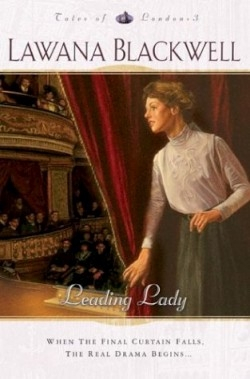
Leading Lady
In London, at the turning of the nineteenth century to the twentieth, Bethia Rayborn, happily engaged to her childhood sweetheart, dreams of their life together as she designs and creates costumes for productions at the Royal Court Theater. She has no idea that a chance meeting with a distant cousin will lead to the destruction of her most cherished dreams. Widowed Lady Muriel Holt, lovely, pampered and willful, has a whim to become an actress. When the Royal Court Theater loses its lead actress, Muriel jumps at the chance to bask in the spotlight. However, she is prompted by a darker motive.
After a serendipitous encounter with Bethia, Muriel’s beloved brother Douglas had pursued the young costume designer in the hopes that he could supplant her fiancé, but Bethia spurned his advances. Rejected, Douglas left to seek his fortune abroad. He leaves his sister and travels to Canada to take part in the Yukon gold rush. Muriel’s fury at Bethia’s rejection of Douglas weaves a dark design of its own, and after Douglas dies while still abroad, Muriel’s grief and pain births a plan that may not only destroy Bethia; it could bring down the Royal Court Theater.
This book is the third in the author’s Tales of London series, novels set during the Victorian era in that city, a world of nobles, servants, orphanages, governesses, and secrets. Her previous trilogy, The Gresham Chronicles, also takes place in England.
Blackwell peoples her tale with strong secondary characters, as well as with the delicious feel of turn-of-the-century London. Muriel is an intricate blend of the spoiled upper class and the vitality of the new century. She scares herself into sleepless nights reading Wells’s War of the Worlds and Stoker’s Dracula while alternately coddling her young daughter and thrusting the girl into the care of the nanny. Bethia’s cousins Jewel and Grady reflect the new class of comfortable tradespeople, and are as well drawn as all the other secondary characters.
The backstage world of the theater comes alive with the ongoing battle between lead actor Richard Whitmore and his nemesis Charlotte Steele. The blurring of class lines and the energy of the new century are deftly woven into the story—a lord from Yorkshire who comes to London to further his acting career hides his title when auditioning, and characters marvel over the Lancaster Instantograph Compact Camera at Harrods, yet women still dress in “half mourning,” and at Girton College for women, Bethia is assured that her unwanted suitor cannot have access to her, as men are not allowed on the school grounds.
Reviewed by
Carol Lynn Stewart
Disclosure: This article is not an endorsement, but a review. The publisher of this book provided free copies of the book to have their book reviewed by a professional reviewer. No fee was paid by the publisher for this review. Foreword Reviews only recommends books that we love. Foreword Magazine, Inc. is disclosing this in accordance with the Federal Trade Commission’s 16 CFR, Part 255.
